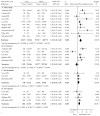Effects of Prenatal Paracetamol Exposure on the Development of Asthma and Wheezing in Childhood: A Systematic Review and Meta-Analysis
- PMID: 36902618
- PMCID: PMC10003539
- DOI: 10.3390/jcm12051832
Effects of Prenatal Paracetamol Exposure on the Development of Asthma and Wheezing in Childhood: A Systematic Review and Meta-Analysis
Abstract
The aim of the report was to evaluate whether in utero exposure to paracetamol is associated with risk towards developing respiratory disorders such as asthma and wheeze after birth. MEDLINE (PubMed), EMBASE and Cochrane Library databases were searched for articles published in English to December 2021. The study involved 330,550 women. We then calculated the summary risk estimates and 95% CIs and plotted forest plots using random effect models (DerSimonian-Laird method) and fixed effect models. We also performed a systematic review of the chosen articles and a meta-analysis of studies based on the guidelines outlined in the PRISMA statement. Accordingly, maternal exposure to paracetamol during pregnancy was associated with a significant increased risk of asthma: crude OR = 1.34, 95% CI: 1.22 to 1.48, p < 0.001; and significant increased risk of wheeze: crude OR = 1.31, 95% CI: 1.12 to 1.54, p < 0.002. Results of our study confirmed that maternal paracetamol use in pregnancy is associated with an enhanced risk of asthma and wheezing in their children. We believe paracetamol should be used with caution by pregnant women, and at the lowest effective dose, and for the shortest duration. Long-term use or the use of high doses should be limited to the indications recommended by a physician and with the mother-to-be under constant supervision.
Keywords: acetaminophen; asthma; paracetamol; pregnancy; prenatal exposure; wheeze.
Conflict of interest statement
The authors declare no conflict of interest.
Figures



References
-
- Williams M.A. Pregnancy complications. In: Louis G.M.B., Platt R.W., editors. Reproductive and Perinatal Epidemiology. Oxford University Press; London, UK: 2011. pp. 101–128.
-
- Lupattelli A., Spigset O., Twigg M.J., Zagorodnikova K., Mårdby A.C., Moretti M.E., Drozd M., Panchaud A., Hämeen-Anttila K., Rieutord A., et al. Medication use in pregnancy: A cross-sectional, multinational web-based study. BMJ Open. 2014;4:e004365. doi: 10.1136/bmjopen-2013-004365. - DOI - PMC - PubMed
Publication types
LinkOut - more resources
Full Text Sources

